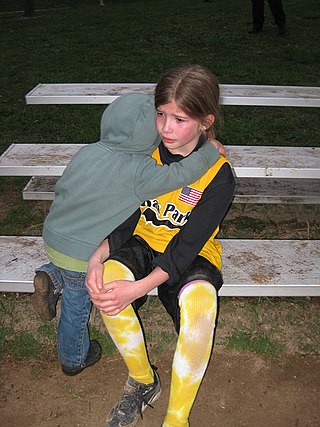Neural mechanisms
This article needs more reliable medical references for verification or relies too heavily on primary sources .(January 2022) |  |
Neural simulation
According to the perception–action-model of empathy, [50] perception–action-coupling (i.e., the vicarious activation of the neural system for action during the perception of action) allows humans to understand others’ actions, intentions, and emotions. According to this theory, when a "subject" individual observes an "object" individual, the object's physical movements and facial expressions activate corresponding neural mechanisms in the subject. [51] That is, by neurally simulating the object's observed states, the subject also experiences these states, the basis of empathy.
The mirror neuron system [52] has been proposed as a neural mechanism supporting perception-action coupling and empathy, although such claims remain a subject of scientific debate. Although the exact (if any) role of mirror neurons in supporting empathy is unclear, evidence suggests that neural simulation (i.e., recreating neural states associated with a process observed in another) may generally support a variety of psychological processes in humans, including disgust, [53] pain, [54] touch, [55] and facial expressions. [56]
Reduced neural simulation of responses to suffering may account in part for observed empathy gaps, particularly in an intergroup context. This possibility is supported by research demonstrating that people show reduced neural activity when they witness ethnic outgroup (vs. ingroup) members in physical or emotional pain. [17] [18] In one study, Chinese and Causian participants viewed videos of Chinese and Causasian targets, who displayed neutral facial expressions as they received either painful or non-painful stimulation to their cheeks. [17] Witnessing racial ingroup faces receive painful stimulation increased activity in the dorsal anterior cingulate cortex and anterior insula (two regions which generally activate during the experience of pain.) However, these responses were diminished toward outgroup members in pain. These results replicated among White-Italian and Black-African participants. [19] Additionally, EEG work has shown reduced neural simulation of movement (in primary motor cortex) for outgroup members, compared to in-group members. [20] This effect was magnified by prejudice and toward disliked groups (i.e. South-Asians, Blacks, and East Asians).
Oxytocin
A great deal of social neuroscience research has been conducted to investigate the social functions of the hormone oxytocin, [57] including its role in empathy. Generally speaking, oxytocin is associated with cooperation between individuals (in both humans and non-human animals). However, these effects interact with group membership in intergroup settings: oxytocin is associated with increased bonding with ingroup, but not outgroup, members, and may thereby contribute to ingroup favoritism and intergroup empathy bias. [58] However, in one study of Israelis and Palestinians, intranasal oxytocin administration improved opposing partisans' empathy for outgroup members by increasing the salience of their pain. [59]
In addition to temporary changes in oxytocin levels, the influence of oxytocin on empathic responses may also be influenced by an oxytocin receptor gene polymorphism, [60] such that certain individuals may differ in the extent to which oxytocin promotes ingroup favoritism.
Specific neural correlates
A number of studies have been conducted to identify the neural regions implicated in intergroup empathy biases. [61] [33] [62] This work has highlighted candidate regions supporting psychological processes such as mentalizing for ingroup members, deindividuation of outgroup members, and the pleasure associated with the experience of schadenfreude.
Role of dmPFC
A meta-analysis of 50 fMRI studies of intergroup social cognition found more consistent activation in dorsomedial prefrontal cortex (dmPFC) during ingroup (vs. outgroup) social cognition. [35] dmPFC has previously been linked to the ability to infer others’ mental states, [63] [64] [65] which suggests that individuals may be more likely to engage in mentalizing for ingroup (as compared to outgroup) members. dmPFC activity has also been linked to prosocial behavior; [66] [67] thus, dmPFC's association with cognition about ingroup members suggests a potential neurocognitive mechanism underlying ingroup favoritism.
Role of anterior insula
Activation patterns in the anterior insula (AI) have been observed when thinking about both ingroup and outgroup members. For example, greater activity in the anterior insula has been observed when participants view ingroup members on a sports team receiving pain, compared to outgroup members receiving pain. [68] In contrast, the meta-analysis referenced previously [35] found that anterior insula activation was more reliably related to social cognition about outgroup members.
These seemingly divergent results may be due in part to functional differences between anatomic subregions of the anterior insula. Meta-analyses have identified two distinct subregions of the anterior insula: ventral AI, which is linked to emotional and visceral experiences (e.g. subjective arousal); and dorsal AI, which has been associated with exogenous attention processes such as attention orientation, salience detection, and task performance monitoring. [69] [70] [71] Therefore, anterior insula activation may occur more often when thinking about outgroup members because doing is more attentionally demanding than thinking about ingroup members. [35]
Lateralization of function within the anterior insula may also help account for divergent results, due to differences in connectivity between left and right AI. The right anterior insula has greater connectivity with regions supporting attentional orientation and arousal (e.g. postcentral gyrus and supramarginal gyrus), compared to the left anterior insula, which has greater connectivity with regions involved in perspective-taking and cognitive motor control (e.g. dmPFC and superior frontal gyrus). [72] The previously referenced meta-analysis found right lateralization of anterior insula for outgroup compared to ingroup processing. [35] These findings raise the possibility that when thinking about outgroup members, individuals may use their attention to focus on targets' salient outgroup status, as opposed to thinking about the outgroup member as an individual. In contrast, the meta-analysis found left lateralization of anterior insula activity for thinking about ingroup compared to outgroup members. This finding suggests that left anterior insula may help support perspective-taking and mentalizing about ingroup members, and thinking about them in an individuated way. However, these possibilities are speculative and lateralization may vary due to characteristics such as age, gender, and other individual differences, which should be accounted for in future research. [73] [72]
Role of ventral striatum
A number of fMRI studies have attempted to identify the neural activation patterns underlying the experience of intergroup schadenfreude, particularly toward outgroup members in pain. These studies have found increased activation in the ventral striatum, a region related to reward processing and pleasure. [74]



